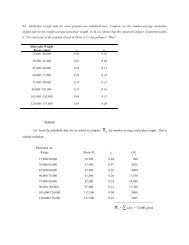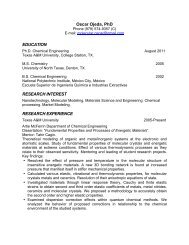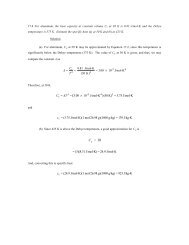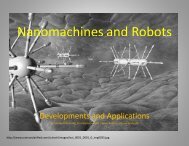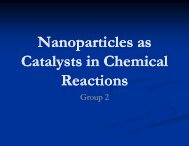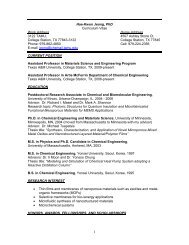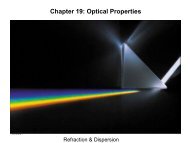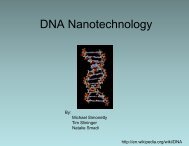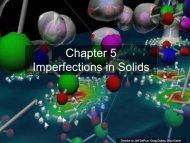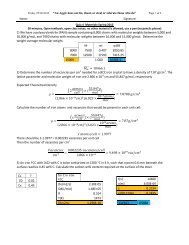SEMINARIO et al.: NANOCELL: CHEMICALLY ASSEMBLED MOLECULAR ELECTRONIC CIRCUIT 1619Fig. 4. Vibrational spectrum taken at one single C–N bond in the backbone of the appoprotein molecule. <strong>The</strong> spectrum not only shows information regarding thevibrational mode corresponding to the C–N bond (the peak ∼38 THz) but also shows information of several other bonds in the molecule such as the C–C bondpeak at ∼39 THz and the small N–H bond stretching peak at ∼102 THz.we have to understand that the concept of gain simply means theability to cause imbalance in charge distributions in devices,thanks to a strategic arrangement of barriers formed by bulkmaterials with different Fermi levels. Molecules do this intrinsicallydue to the localized nature of their molecular orbitals.<strong>The</strong>refore, the equivalent to gain in molecular devices comesfrom the local concentration of charge at some regions of spacein the molecule (device), certainly at expenses of a depletionof charge in others, thus the strategic location of the input andoutputs regions.A related concern is the input–output isolation, causing theoutputs inability to modify the inputs, while the outputs aremodified by the inputs. This is what allows us to interconnectthe outputs of some devices to the inputs of others withoutinterfering anything. We have demonstrated that this is possibleby interconnecting the output of two gates to the input of a thirdone. <strong>The</strong> truth table obtained was exactly what was expectedfrom their logical functions [85].Eventually, all molecular gates would be attached to a substratein a planar configuration (Fig. 1), and the MEP on topof the molecules used for computation may change slightlywhen the bottom of the molecules are attached to the substrate.Once an assembly technique is proposed to attach the moleculesto a substrate, further calculations will be needed, consideringnot only the molecular gates but also the effects of substrateand of the interface to the microscopic world. Certainly, theinterface to the microscopic world would require of a MEPcurrentconverter. Notice that, at this point, only the results ofthe internal computation at the molecular level will need to betransmitted.<strong>The</strong> other scenario is the use of vibronic states [17]–[19],[86]–[90]. Atoms in molecules have vibrational states due tothe combined effect of nuclei and electrons. Any displacementof nuclei will generate a corrective force in the oppositedirection, following a quadratic law for small displacements.Molecules with N atoms have 3N-6 vibrational states and 3N-5if they are linear. <strong>The</strong>se vibrational states are discrete, andthey should show up as vertical lines in an exact spectrum.As the number of atoms increases in the molecule, these linesget closer and closer forming bands in bulk materials. <strong>The</strong>interesting feature is that most of the molecular vibrations arein the range of 0–100 THz; this corresponds to the range of0–3333 cm −1 . In addition, several quasi-1-D systems likeproteins, DNA, RNA, etc., are macroscopically large inone direction and nanoscopically small in the other two.<strong>The</strong>refore, the presence of bands, rather than discrete states,is possible in long biomolecules. Thus, we can use thesebands to transmit information in “linear” or long molecularsystems, and perhaps, this is the way in which signals aretransmitted at the molecular level in biological molecules. Thisis also the basis of terahertz molecular electronics, wherebysignals are coded in molecular vibrations. An interesting exampleis shown in Fig. 4, which is the spectrum observedfrom the variations of a CN bond length in the appoproteinmolecule. <strong>The</strong> simulation of this whole system, includingthe solvent, required 92 224 atoms, for which molecular dynamicsequations were solved every 0.1 fs for a total timeof 1 ns [17].<strong>The</strong> time signal of the variations of length of the C–N bondwas processed by a fast Fourier transform algorithm in orderto obtain the spectrum shown in Fig. 4; the signal taken atsuch a local site yielded an spectrum that shows not onlythe vibrational states corresponding to the CN vibration butpractically has information of other vibrations taking place faraway from the local site. <strong>The</strong>refore, this shows that every bondin the molecule has information regarding the other bonds inthe long molecule. Amazingly, this is the way that signals canbe transmitted in nanoscale circuits. We perform a theoreticalexperiment to transmit a signal through molecule. When wecode a signal using frequency modulation, we choose thecarrier frequency to be one of the peaks of the C–N vibrationalfrequency spectrum, which is 24 THz, as shown in Fig. 4. Weinject the signal into the backbone of the molecule GLY58and simulate the whole system using the NAMD moleculardynamic simulation program [91]. <strong>The</strong> position of each atom inthe system is recorded in every 0.1 fs. After the simulation, thesignal was processed using digital signal processing techniques[92], and the result is shown in Fig. 5, in which we can seeclearly that the injected signal is indeed transmitted through themolecule. A detailed description of this can be found in [17],[83], [87], [90], [93]–[97]. Using vibrational modes to transmitsignals, there is no need to actually send currents of electrons,but just introducing vibrational signals at one site would allowus to send signals along the backbone of the molecules. <strong>The</strong>mechanism for this is the resonance of the carrier signal with thenormal vibrational modes along the backbone of the molecule.This allows the carrier signal to travel along the backbone ofthe molecule without much loss in amplitude. Certainly, this isneeded for distances smaller than the technologically availablelithography.
1620 <strong>IEEE</strong> SENSORS JOURNAL, VOL. 6, NO. 6, DECEMBER 2006Fig. 5. Signal transmitted through the molecule Ala30 using amplitude modulation. Signal is introduced at point A and recovered at points B-H. Some degradationof the shape of the signal along the molecule is observed.Signal modulation in a molecular circuit has been theoreticallydemonstrated using molecular dynamics and digital signalprocessing techniques, and recently, a study using biologicalmolecules showed the possibility of transmitting signals [17].Finally, there are other alternatives for the encoding andtransport of information in nanosized systems. One with excellentperspectives is spintronics based on the use of the spinof elementary particles to store information; thus, the use ofspin currents to transfer information would be another possibleway, which is still under experimentation. It also opens thedoor to practical developments of quantum computing [98],[99]. Alternative ways are the use of conformational modes ofmolecules to store information, such as the mechanical bond,formed when two molecules are together simply because oftheir geometric arrangement. For instance, for two cyclic interlacedmolecules, they do not have any chemical bond to keepthem together but just the nature of their geometry [23]–[25].Other alternatives might be the use of bond breaking and bondforming to represent the OFF and ON digital states [28], respectively,or simply the use of rotational or translational modes.Another possibility is the use of the torsional effects in oligophenyleneethynylene,whereby the rotation of one ring withrespect to the others yields a large change in conductance [26],[27], [100]. <strong>The</strong> use of charge methods, where the net charge issimply one or two electrons, is also being extensively studiedby several research groups [101]–[103]. All these mechanismscan also be used in nanocells.VI. NANOCELL CONCEPT<strong>The</strong> nanocell can be defined as an arrangement of moleculesspecially designed to assemble a programmable but not directlyaddressable network. Fig. 6 shows a nanocell structure preparedlithographically. <strong>The</strong> yellow contacts are addressable externally,and their separation is limited by the minimum featuresize that is possible using lithographic techniques. <strong>The</strong> figureis not at scale as the tips or contacts look much closer thanthe actual relative distance in a real nanocell. <strong>The</strong> moleculesinterconnecting the clusters are ∼2-nm long, and the sizes ofFig. 6. Example of a nanocell (elements not to scale). <strong>The</strong> active moleculesyield a network with the help of metallic clusters to two per side only and makethem big, as in Fig. 1.the clusters (green) are very similar in diameter to the lengthof the molecules. If present technology is used to make thenanocell, the contact pitch and size are in the order of ∼40 nm.Molecules with special features are interconnected usingmetallic clusters. <strong>The</strong> molecules and clusters do not necessarilyform a well-defined pattern; however, the contacts can be usedto program the behavior of the molecules. In order to have programmabledevices, it is required that the molecules show programmabilitycharacteristics. This is possible if the moleculespresent highly nonlinear characteristics. As it has been alreadytheoretically and experimentally demonstrated, this is the caseif the molecules feature a negative differential resistance (NDR)[3], [13], [104]–[109]. It can be shown that even two moleculesin series can yield multivalue I–V characteristics and thusallowing us to play (or to program), with a purpose, the possiblestates at a given bias potential, thus compensating for the lackof addressability of single molecules. An example is given in
- Page 1 and 2: 1614 IEEE SENSORS JOURNAL, VOL. 6,
- Page 3 and 4: 1616 IEEE SENSORS JOURNAL, VOL. 6,
- Page 5: 1618 IEEE SENSORS JOURNAL, VOL. 6,
- Page 9 and 10: 1622 IEEE SENSORS JOURNAL, VOL. 6,
- Page 11 and 12: 1624 IEEE SENSORS JOURNAL, VOL. 6,
- Page 13: 1626 IEEE SENSORS JOURNAL, VOL. 6,




